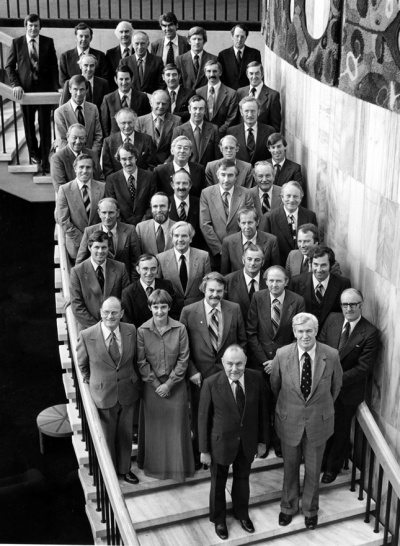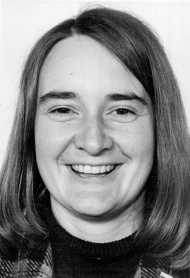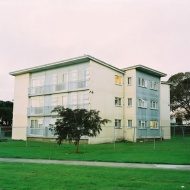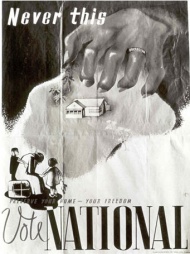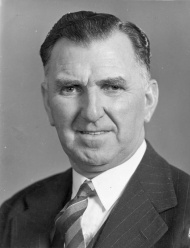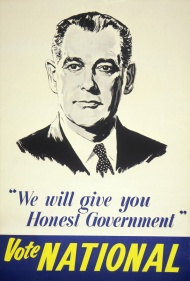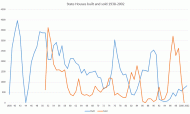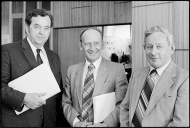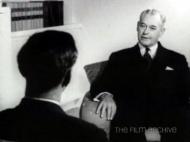Events In History
-
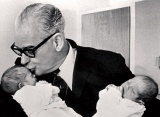 26 November 1960'Kiwi Keith' begins 12-year tenure as prime minister
26 November 1960'Kiwi Keith' begins 12-year tenure as prime ministerKeith Holyoake led the National Party to victory over Walter Nash’s Labour government. He went on to become New Zealand’s third longest-serving prime minister, behind Richard Seddon and William Massey. Read more...
-
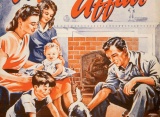 30 November 1949Election of first National government
30 November 1949Election of first National governmentThe Labour government led by Peter Fraser was defeated by Sidney Holland’s National Party after 14 years in office. The result heralded a long period of National dominance, with the party holding power for 29 of the next 35 years. Read more...
-
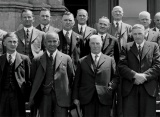 13 May 1936National Party founded
13 May 1936National Party foundedFollowing their crushing defeat by the Labour Party in the 1935 general election, the remnants of the United–Reform coalition government met in Wellington to establish a new ‘anti-socialist’ party. Read more...
Articles
The 1951 waterfront dispute
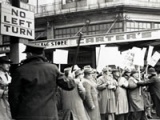
The 1951 waterfront dispute was the biggest industrial confrontation in New Zealand’s history. Although it was not as violent as the Great Strike of 1913, it lasted longer – 151 days, from February to July – and involved more workers.
-
Page 4 – Division and defeat
The watersiders’ militancy had isolated them from most unionists and Walter Nash’s Labour Party Opposition sat uncomfortably on the fence, denouncing government repression but
State housing

New Zealand's first state house was formally opened on 18 September 1937. But the government has provided rental housing for New Zealanders for more than a century. Explore the history of this country's various state housing schemes and their contribution to the New Zealand way of life.
- Page 3 - The state steps in and outThe National government introduced full market rents in 1991 to reduce the state role in housing provision. From the start, public debate over state housing policy in New Zealand
The 1970s
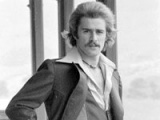
The 1970s were an era of economic and social change. Global oil shocks hit the New Zealand economy hard, while protests against the Vietnam War and nuclear testing continued. A new generation of activists raised questions about race relations, sexuality and the welfare system in New Zealand.
- Page 2 - OverviewSummary of what NZ was like in the 1970s, including our population, economy, popular culture, protest issues, politics and sporting
The New Zealand Legion
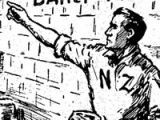
The year 1933 witnessed an unprecedented eruption of protest amongst urban businessmen and professionals in New Zealand. The most prominent manifestation of this protest was a radical conservative movement named the New Zealand Legion.
- Page 7 - DeclineInternal divisions and resignations over policy had considerably sapped the New Zealand Legion’s strength by the beginning of
Biographies
-
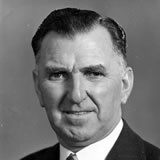 Holland, Sidney George
Holland, Sidney George
Holland became PM in 1949. A year later he abolished the Legislative Council, and in 1951, after winning the Waterfront Dispute, he increased his majority in a snap election.
Read more... -
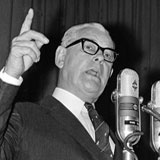 Holyoake, Keith Jacka
Holyoake, Keith Jacka
‘Kiwi Keith’ Holyoake, the first officially designated deputy PM (1954) was our third-longest serving leader.Although criticised for sending troops to the Vietnam War, he is now seen as ‘the most dovish of the hawks’, doing the bare minimum to keep America happy.
Read more... -
 Marshall, John ('Jack') Ross
Marshall, John ('Jack') Ross
‘Gentleman Jack’ Marshall, for long – too long, he felt towards the end – Keith Holyoake’s deputy, spent mere months as PM, but served Cabinet well for two decades.
Read more... -
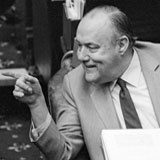 Muldoon, Robert David
Muldoon, Robert David
Rob Muldoon was one of our most polarising PMs, the voice of ‘the ordinary bloke’ to supporters and a dictatorial bully to critics.
Read more... -
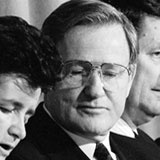 Bolger, James Brendan
Bolger, James Brendan
New Zealand’s most openly republican PM, Jim Bolger presided over major electoral reform and Treaty of Waitangi settlements and outflanked Cabinet opposition to funding the new national museum.
Read more... -
 Shipley, Jennifer Mary
Shipley, Jennifer Mary
New Zealand’s first woman PM, Jenny Shipley came to power in 1997 after staging a carefully planned coup against Jim Bolger.
Read more... -
 Key, John Philip
Key, John Philip
John Key’s prime ministerial parliamentary apprenticeship is the shortest since David Lange’s. Like Lange, he is one of the few recent PMs without prior Cabinet experience.
Read more... -
 English, Simon William (Bill)
English, Simon William (Bill)
Like Jack Marshall, Bill English served a long and distinguished political apprenticeship prior to becoming PM
Read more... -

Christopher Luxon became New Zealand’s 42nd prime minister after serving one of the shortest political apprenticeships in the country’s history.
Read more...
Related keywords
- prime ministers
- women in politics
- great depression
- new zealand legion
- economy
- sidney holland
- robert muldoon
- 1970s
- beehive
- womens liberation
- nuclear free
- suffrage 125
- labour party
- norman kirk
- cartoon
- elections
- bill english
- state housing
- market rents
- keith holyoake
- 1960s
- socialism
- parliament
- governor-general
- MPs
- paul reeves
- jim bolger
- waterfront dispute
- john marshall
- international trade
- poster
- housing
- crime
- gay rights
- homosexuals
- venn young
- television
- film
- broadcasting
- protest
- demonstrations
- strikes
- workers rights
- trade unions
- fintan patrick walsh
- vietnam war
- MMP
- john key
- flats
- liberal party
- john a lee
- social policy
- jenny shipley
- sport
- popular culture
- CER
- springboks
- advertising
- superannuation
- cold war
-
Main image: National Party caucus, c. 1979
Prime Minister Robert Muldoon with his National Party caucus.

